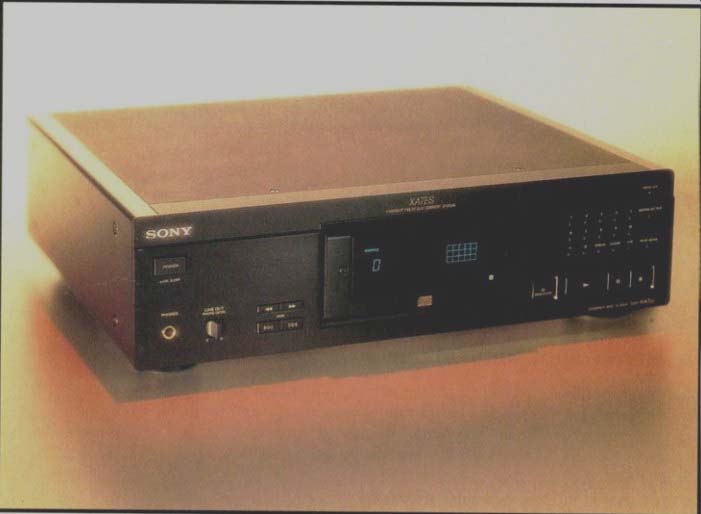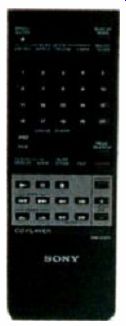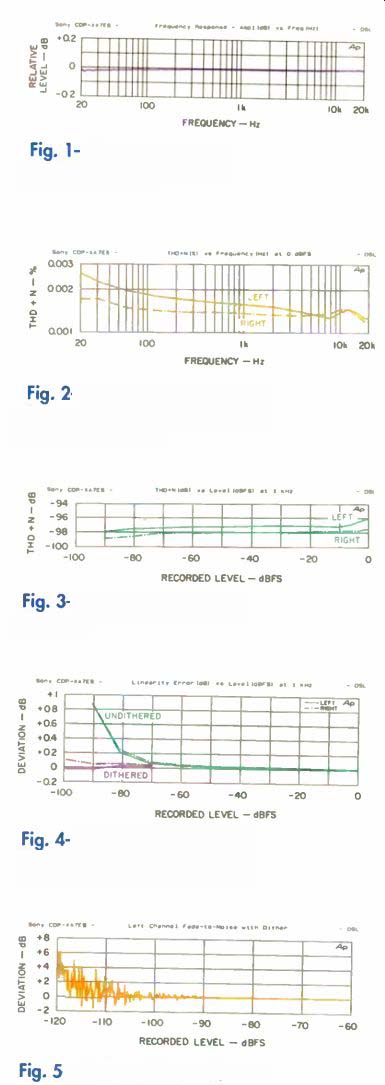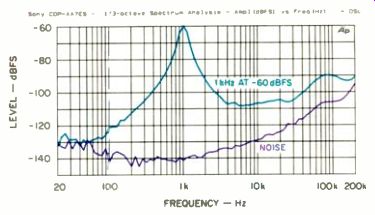
Manuf. Specs:
Dimensions: 17 in. W x 5 in. H x 14 7/8 in. D (43 cm x 12.5 cm x 37.5 cm).
Weight: 33.1 lbs. (15 kg).
Price: $3,000.
Company Address: Sony Dr., Park Ridge, N.J. 07656; 201/930-1000.
-------------
Crowning Sony's "ES" series of CD systems is the CDP-XA7ES, a single-disc player obviously aimed at the high-end market. The CDP XA7ES costs considerably more than other Sony ES players, but, in the esoteric league in which it plays, it's downright economical. The CDP-XA7ES features digital servo control and improved chassis construction. But what sets this player apart from its siblings is a "super-rigid vibration-reducing frame" (weighing more than 30 pounds), "the latest refinements in digital filtering, twin round-core power transformers, and a class-A output stage." That said, the two things I find most intriguing about the XA7ES are its fixed-pickup laser-tracking assembly (said to improve stability and re duce digital error rate) and its use of a disc stabilizing weight, a technique long in vogue among manufacturers of esoteric top-loading players but seldom used by those who cater to a wider audience.
Unlike a top-loader (which demands topmost position for access in an equipment rack), the CDP-XA7ES loads conveniently from the front. The CD is placed, la bel side up, on a conical pillar and rests on a disc just slightly larger than the CD's center hole. The conical pillar centers the disc, while an elastomeric ring on the small sup porting platter provides traction. A stabilizing block (which weighs about 4 ounces and must be in place for the system to operate) slips over the spindle and holds the CD against the ring. Felt on the underside of the weight helps protect the disc.
As the drawer accepts the disc (which occurs with remarkable silence and seeming precision), the spindle can be seen to advance the disc further inward to locate it above the laser head. Although you can't see the spindle while the disc is playing, it presumably continues to move the disc with respect to the laser head rather than spinning it in a fixed position and moving the laser to achieve tracking, as conventional CD players do.
The CDP-XA7ES has both balanced and unbalanced analog outputs, the former via base-metal XLR connectors, the latter via gold-plated RCA pin jacks. Two sets of unbalanced outputs are provided, one at fixed level and the other controlled by a front-panel knob that also adjusts headphone level. The line outputs are on the back; a gold plated headphone jack is up front, near the "Line Out/Phone Level" control. The balanced outputs can be switched off by a hack-panel slide switch. Optical (Toslink) and coaxial (gold-plated RCA) digital out puts on the back are energized by a front-panel button; an LED indicates when they're in use.

The CDP-XA7ES has the features you'd expect in a Sony player (and often won't find on esoteric models), including shuffle ( random) play, program play, delete play ( an alternate version of program play that enables you to delete tracks you don't want to hear), and custom index play (playback between two user-set index points). "Shuffle," "Program," and "C. Index" play are invoked from the front panel by pressing "Play Mode" multiple times; from the re mote, they're accessible directly.
Delete play can be combined with shuffle play to randomize all tracks not deleted. Re peat play can continuously repeat the disc, a track, the contents of the program memory, or the custom-marked section as well as continually randomize playback of the disc with or without "track deletions." There's also music scan to play the beginning of each track in sequence; the scan duration defaults to 10 seconds but can be increased to 20 or 30 seconds if desired.
Sony has also simplified recording from the CDP-XA7ES (although its lesser sib lings in the ES line are even more flexible in this regard). With the XA7, you can create a program of up to 24 tracks, check the timing, and, if needed, divide the program in two for recording both sides of a cassette.
(The pause that's inserted at the dividing point counts as a track.) "Auto Space" inserts 3 seconds of silence between pro grams, while "Peak Search" locates the highest level among the tracks to be recorded and repeats that portion of the program to facilitate setting the recording level. When recording from the analog outputs, you can manually fade in and out and adjust the fade time from 2 to 10 seconds (the default is 5 seconds long).
The CDP-XA7ES can store as many as 224 "Custom Files." These can be of two types: a "Custom Index" (which can contain up to eight marking points for a disc of 32 or fewer tracks and up to five marking points for discs with more than 32 tracks) and a "Delete Bank" (which stores instructions to omit the playing of specific tracks). If both types of files are used for a disc, they're stored separately and count as two "files." You can check the number of custom files retained by the player at will and erase the files for a disc if that disc is loaded. All custom files are erased if you don't use the player for a month.
The CDP-XA7ES has the nor mal transport controls on its front panel, including skip forward and back, "Check" and "Clear" for programming, and 12 keys for direct access to the first 12 tracks (plus a ">12" key to cue the remaining ones). The remote has enhanced versions of some of these functions, such as direct access to the first 20 tracks (plus a ">20" button) and both slow and fast music search. The remote also has some features not on the panel. For example, it has keys for cueing to pre recorded index points. It also enables you to adjust the level at the variable output jacks and to institute fades. It is the only means of initiating a peak search or mu sic scan, activating and clearing the repeat function, marking portions of the disc for repeat A-B play, toggling the display through its three time modes, and activating or defeating the "Music Calendar" track display. The remote is the more convenient way to cancel random play, as it has a "Continue" key that immediately restores normal operation. From the front panel, cancelling shuffle play requires that you tap the "Play Mode" button four times.
Measurements
=========
Measured Data:
Line Output Voltage for 0-dBFS Recorded Level: Fixed-level unbalanced output, 2.57 V; variable-level unbalanced output, 2.42 V maximum; balanced output, 2.65 V; headphone output, 3.86 V.
Channel Balance: ±0.005 dB.
Line Output Impedance: Fixed-level unbalanced output, 100 ohms; variable-level unbalanced output, 200 ohms; balanced output, 300 ohms; headphone output, 105 ohms.
Frequency Response: +0.01,-0.02 dB from 20 Hz to 20 kHz.
THD + N at 0 dBFS: Less than 0.0027% from 20 Hz to 20 kHz.
THD + N at 1 kHz:-96.2 dB from 0 to -90 dBFS and -97.2 dB from -30 to -90 dBFS.
Maximum Linearity Error: To -90 dBFS with undithered recording, 0.87 dB; to -100 dBFS with dithered recording, 0.11 dB.
A-Weighted S/N for Infinity-Zero Signal: 126.1 dB.
Quantization Noise: -97.6 dBFS.
Dynamic Range: Unweighted, 98.8 dB; A-weighted, 101.1 dB.
Channel Separation: Greater than 118.5 dB from 125 Hz to 16 kHz.
=========

Fig. 1-Frequency response.
Fig. 2-THD + N vs. frequency.
Fig. 3-THD + N vs. level.
Fig. 4-Deviation from linearity.
Fig. 5-Fade-to-noise test.
Wow! What a wonderful player! It simply sailed through my test sequence. Rarely do I find a product that doesn't make my eye brows rise quizzically on one test or another, but the CDP-XA7ES was flawless.
We often speak of "ruler-flat" frequency response, but what does that mean? If you make the scale crude enough, you can make the response of any product look ruler flat. This one's is ruler flat with the most expanded (sensitive) scale I have ever used (Fig. 1)! There is nary a ripple, sag, dip, or peak. The channels are balanced within the limits of measurement accuracy. So is response. Incredible! Now look at the plot of the Sony player's total harmonic distortion plus noise (THD+ N) versus frequency (Fig. 2). The test is made at 0 dBFS, that is, at maximum recorded level. Check the vertical scale; it's much tighter than I've ever used before.
Normally, THD + N rises at frequencies above a few kilohertz, often reaching sever al tenths of a percent (sometimes higher than that!) between 8 and 16 kHz. This curve stays well below 0.002% across al most the entire frequency spectrum! Shift now to THD + N versus level at 1 kHz (Fig. 3). I have retained my "normal" scale here (although the CDP-XA7ES uses little of it!) just to make a point. I've never tested a CD player or D/A converter whose THD + N remained below-96 dB at all signal levels. Usually, THD increases toward 0 dBFS as the analog electronics get into trouble. Hence, and to account for the curve discontinuities common with "scaling" DACS (which use gain-compensated bit-shifting), I've been giving two results for THD + N at 1 kHz in "Measured Data." One gives the maximum reading over the full dynamic range (0 to-90 dBFS); the other gives the worst reading over the lower operating range (-30 to-90 dBFS). The two numbers for the CDP-XA7ES are very close, which demonstrates that it works extraordinarily well at all recorded levels.
I've also used my tightest scale for the curves of linearity error versus level (Fig. 4).
Whether a dithered or undithered recording is played, Sony's converter matches the best stand-alone D/A converters I've measured, vis-à-vis linearity, and is far superior to what you typically find in CD players.
The fade-to-noise plot (Fig. 5) tells the same story: far better than run-of-the-mill and a match for the best.
Figure 6 shows spectrum analyses taken on the left channel when the CDP-XA7ES was reproducing the "infinity-zero" track of the CBS CD-1 test disc and when reproducing a 1-kHz signal recorded at-60 dBFS. Once again, I've had to adjust my scale range, this time downward by 10 dB to show the residual noise. Note the absence of power-line "hum" components in the noise plot. This testifies to excellent power-supply filtering and superior circuit layout. Overall, the noise plot lies 5 dB or more below what is typical of a good player, and the 1-kHz,-60 dBFS plot shows negligible odd-order distortion.
The absence of analog circuit noise also is apparent in the A-weighted S/N listed in "Measured Data" (data is shown only for the "worse" channel). The left channel came in at 126.1 dB, which, if memory serves me right, is a new record! The noise in the right channel was so low that I could not get consistent readings. The data for quantization noise reflects granularity in the conversion process. Once again, Sony has established a new benchmark. Ditto when it comes to dynamic range, also listed in "Measured Data." I've never before seen A-weighted dynamic range figures greater than 100 dB, much less unweighted ones that, worst case, approach 99 dB. Channel separation also was stellar. I'm not sure who needs channel separation that exceeds 130 dB (worst case) over the meaningful frequency range, but, if nothing else, it sure is testimony to excellent circuit layout.
I took most of the data I've discussed using the fixed-level unbalanced outputs, which is probably the way most readers will use the CDP-XA7ES. I did rerun the frequency response sweeps through the vari able-level unbalanced outputs as well as the balanced outputs. Except for the differences in output level in "Measured Data," the results were identical, and channel balance was equally good. In general, output levels are 1.5 to 2.5 dB higher than the quasi-standard 2 volts. Should this present an over load problem to a downstream processor (it shouldn't with a well-designed system), you can always use the variable output and turn the level down slightly. Source impedance from each output is low, and the player can even drive 50-ohm loads to full level with out difficulty. Preamp input impedance and interconnect cable capacitance clearly are

Fig. 6--Spectrum analysis of 1-kHz and "infinity-zero" tracks.
Use and Listening Tests
What wonderful sound! No CD player I had in house at the time held a candle to the Sony CDP-XA7ES. Its sound was utterly transparent, amazingly detailed, and remarkably clean. The XA7ES added so few artifacts of its own that, for better or worse, I heard every wart in every recording: the almost subliminal ambient noise of the Troy Savings Bank Music Hall in Colin Tilney's recording of Bach's The Seven Toccatas for Harpsichord (Dorian DOR-90115);
the slight shift in pitch that can occur when a piano's una corda pedal is held and the damper released, as on Schumann's "Carnaval" and "Kreisleriana," with Mitsuko Uchida on piano (Philips 442 777-2); and the breath sounds that accompany the low-level flute passages in the final movement of Mahler's Symphony No. 2, "Resurrection," with the St. Louis Symphony Orchestra under Leonard Slatkin (Telarc CD-80081/82). These "warts," if one may call them that, are unavoidable when real people play real instruments in a real acoustic environment. They should be re produced; they are part of the sonic experience. But, even more remarkable-and much more enjoyable-were the musical accuracy and presence that this player de livered at all levels.
Mahler's "Resurrection," cited above, is an old CD (recorded in 1982) but is remarkably clean and underwent absolutely no dynamic-range compression at any step in the production chain. As a result, the disc has unusual dynamic range; quiet passages are really quiet, to allow room for the tremendous climax at the conclusion of the symphony. If you turn the level up in the quiet sections, you can often hear the low-level granularity that CD players are wont to introduce. But not with the CDP-XA7ES. Low-level woodwinds, like flute and clarinet, retained their character at all levels. Furthermore, the bass line was extremely tight, solid but not flabby, and Kathleen Battle's voice sounded simply sublime. Maureen Forrester sounded, well, like Maureen Forrester of that time, experienced but showing some age. I also was impressed by the absence of intermodulation between brass and strings and by the cleanliness of the choral sections. Imaging was as good as I've ever heard from this two-disc set.
The Sony player's ability to reveal subtle differences in tonal character also was apparent in Itzhak Perlman's recording of Bach's Sonatas and Partitas (EMI Classics ZDCB 49483-2). I could hear the difference between the two violins he used for this two-disc set. What's more, the tiny instrument noises that even a violinist of Perl man's stature creates were clearly resolved.
To assess smoothness, I listened to how the CDP-XA7ES handled Mozart's "Eine Kleine Nachtmusik" with the Academy of Ancient Music under Christopher Hog wood (L'Oiseau-Lyre 411720). The sound on this disc, rather bright to begin with, is made even more shrill by the lack of vibrato. Yet the Sony player made the music sound "right," whereas lesser players can get downright harsh. The CDP-XA7ES clears away the veil between the listener and the music. I heard subtleties and detail on this disc that I had never heard before; I had neither been aware that the bass line was quite so tight and solid as the Sony displayed it to be nor that the imaging was quite so good as it really was. I could cite other examples of this player's remarkable smoothness and musicality, but I think I've made my point.
The Sony CDP-XA7ES is the finest-sounding CD player that's entered my listening room; it's also the finest CD player to have crossed my test bench. I consider it truly world-class and a reference against which others are to be compared. Among run-of-the-mill CD players from the Far East, the CDP-XA7ES is expensive. compared with many esoteric players, it's a flaming bargain. For as long as I can keep it or until another replaces it at the pinnacle of perfection, the Sony CDP-XA7ES will be my reference CD player.
-EDWARD J. FOSTER
(Source: Audio magazine, Mar. 1996)
Also see:
Sony CDP-X7ESD CD Player (EQUIP. PROFILE, Nov. 1989)
Sony CDP-X77ES CD Player (Jun. 1990)
Sony CDP-620ES CD Player (Sept. 1985)
Sony CDP-610ES CD Player (Nov. 1984)
Sony CDP-650ESD Compact Disc Player (July 1985)
= = = =